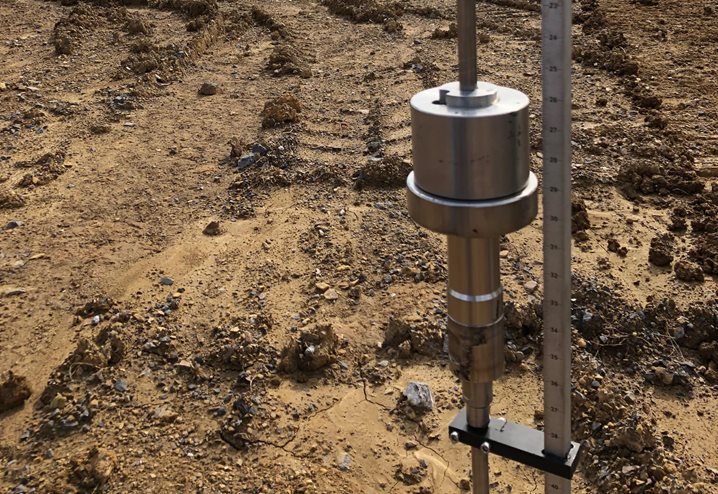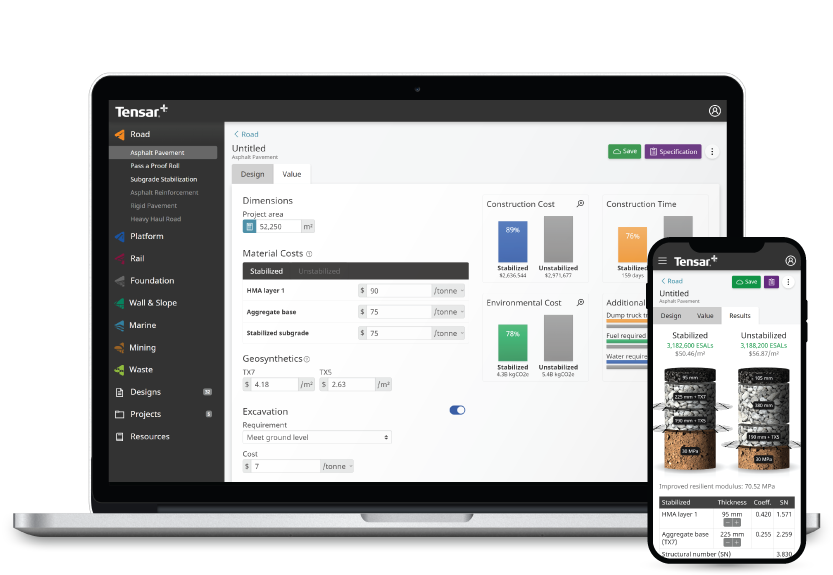
Subgrade Stabilization
Solve your soft soil problem
Almost every engineer and contractor has seen it before: you head to work, but you can’t get onto the site because of poor site conditions or wet weather. Equipment and manpower costs you time and money while you wait for the site to dry, or you over-excavate and import expensive fill. Maybe you try a layer of fabric, but if the soil is too soft, installation may be impossible.
There’s a better method for subgrade soil stabilization: Tensar geogrids. Since they are easier to install, reduce aggregate fill, and require no skilled labor or specialized equipment, Tensar geogrids can help you quickly get the job done on time and on budget. Plus, a more stable, stiffer pavement foundation creates a more resilient, longer-lasting surface.
Estimating Soil Strength & Cost to Repair
Soft soils can bring productive job sites to a grinding halt. The first step is to estimate the soil strength and the cost to bridge soft soils.
The dynamic cone penetrometer (DCP) is one of the most efficient and effective tools available for evaluating the strength of soils on site. It is also used to monitor the condition of granular layers and subgrade soils in pavement sections over time. Tensar and our partners routinely use the DCP to help engineers and contractors determine the right solutions for their sites, especially when soft soils are involved.
Compare Methods for Repairing Soft Soils
Is your go-to method for soil stabilization actually the fastest or most cost-effective? Common methods like over-excavation and chemical stabilization are actually costing you more than you realize, whether that cost lies in expensive fill or a lengthy curing period. Fabrics, meanwhile, can’t be used everywhere, and they may require such a large fill thickness that they hardly seem worthwhile.
In this side-by-side comparison chart, we compare the pros and cons of several techniques and how much aggregate is required. So, how does your current method stack up?
The Power of Geogrids
For stabilizing aggregate, especially over weak subgrades, stiffer is better. Tensar’s technology and expertise in ground stabilization not only improve site performance but are proven to reduce costs and environmental impact. Our innovative geogrid solutions provide effective confinement of granular fill, resulting in a stiff mechanically stabilized layer (MSL) capable of controlling differential settlement and increasing bearing capacity.
With Tensar geogrids, you need less aggregate to stabilize your job site – and less aggregate means less cost. They’re fast and easy to install, which means less time lost from your project schedule. And Tensar geogrids are backed by thousands of hours of testing and research, so you can trust the results.
Success Stories
Subgrade Stabilization Products & Systems
There are no results that match your search. Please try another search or Contact Us with further questions.
 Tensar+
Tensar+
Design with confidence, from anywhere.
- Design & evaluate pavement and gravel sections, working platforms, sub-ballast sections & more
- Easily compare alternative materials
- Determine initial and lifecycle cost savings, time savings, and sustainability metrics
- High-level summary of the design alternatives for project stakeholders
- Sharing features that aid collaboration

Resources
Developing More Reliable Designs with Tensar+ Software
Develop more accurate, cost-effective designs with Tensar+ software. Learn more and see examples of successful projects that also relied on this...Extend the Service Life of Concrete Structures with Performance Reinforcing Steel
This months Tensar webinar will move outside our normal geotechnical focus to look at reinforced concrete design and the problem of rebar corrosion in...Interlayers Product Selection Guide
Choose the pavement reinforcement system that is right for your application.Your Regional Sales Manager
Your Inside Sales Manager
Your Local Distributor
There are no results that match your search. Please try another search or Contact Us with further questions.


